
Birds of California
Birding is by many accounts the second most popular outdoor activity in the U.S.— and it is possible to see more species in California than in all but two states! There is always something of interest to see, whatever the season.
The Golden State supports over 700 species of birds, from the more common species like Robins and Flickers to many less noticeable ones such as the Bufflehead or California Gull.
California has both marine and terrestrial avian residents with waterfowl residing on bays, lakes, and estuaries up through the coastal wetlands which extend inland into agricultural valleys where grassland birds congregate.
Would you like to enrich your “life bird list” with species like Allen’s Hummingbird, Spotted Dove, Mountain and California Quail, Western and Island Scrub-Jays, Wrentit, CA Thrasher, and Oak Titmouse?
How about White-headed, Acorn and Nuttall’s Woodpecker, Pacific-slope Flycatcher, California Gnatcatcher, California Thrasher, Tricolored Blackbird, Lawrence’s and Lesser Goldfinches and the western/California species of loons, cormorants, rocky shorebirds (including tattlers, turnstones, surfbirds, and tattlers), near-shore shearwaters, gulls, terns, thrashers, warblers, towhees, and other residents and migrants? Naturalized parrots, such as Mitred and Yellow-chevroned Parakeets, and finches such as Nutmeg Mannikin and Orange Bishops are also on the list of birds you can see here.
Table of Contents
Northwestern California
Visiting Northwestern California can be a great opportunity for birders. From Marbled Murrelets along the coasts to Laysan Albatross on pelagic trips, from wintering Bald Eagles along Cache Creek to rare migrants at Point Reyes, the opportunities abound. Personally, I never get tired of checking the Cypress trees at Point Reyes for any number of rare migrants.
Point Reyes National Seashore
Point Reyes National Seashore is well known for its excellent birding and large numbers of rarities. Located along the California coast along Highway 1 between San Francisco and Bodega Bay, the seashore offers many different habitats and birding opportunities and happens to be one of my favorite birding locations in California.
The towns of Olema and Inverness offer lodging and other accommodations very close to the park. To reach the park, you can either take the Sir Francis Drake Blvd exit along Highway 1 in Olema and head west into the park, or take the Sir Francis Drake exit from Highway 101 near San Rafael.
Cache Creek
Besides being the location of a major Native American Casino, portions of Cache Creek can provide excellent viewing opportunities for Bald Eagles. The Oak and mixed woodlands of the area are also home to species such as Pileated Woodpecker and large mammals such as Black Bear and Elk.
Northeastern California
Birding northeastern California can be very rewarding. The volcanic Cascades provide a home to species like Gray Jay, Williamson’s Sapsucker, and Northern Goshawk. Sagebrush plains are home to Pinyon Jays and Sage Grouse. The Klamath Basin has one of the largest wintering populations of Bald Eagles in the country. All these things make birding in this part of the state incredibly varied.
Klamath Basin
The Klamath Basin region offers a good number of birding locations. The Area is home to species such as Bald and Golden Eagle, Swainson’s, Ferruginous, Red-tailed, and Rough-legged Hawks, Sage Grouse, thousands of geese, Loggerhead and Northern Shrike, Short-eared Owl, Sandhill Crane, and many other mountain, grassland, sage and wetland species. Habitat in the Klamath Basin area varies quite a bit.
Lassen Volcanic National Park
Lassen Volcanic National Park is home to a variety of mountain species including Gray Jay, Clark’s Nutcracker, Sooty Grouse, Pileated Woodpecker, and Black-backed Woodpecker.
Central California
The region can produce such specialties as Yellow-billed Magpie, Tricolored Blackbird and Mountain Plover. Thousands of ducks, geese, swans, and cranes winter in areas like Cosumnes River Preserve and Merced NWR. Flood and Waverly roads produce species like Burrowing Owl, Ferruginous Hawk, Rough-legged Hawk, and Merlin.
Merced NWR
Merced NWR is an excellent place to see thousands of waterfowl in the winter. Species such as Snow, Greater White-fronted, Canada, Cackling, and Ross’s geese and Sandhill Cranes winter here in large numbers. Raptors such as Bald Eagle are also seen here.
Cosumnes
Cosumnes River Preserve is home to many wintering waterfowl including thousands of Sandhill Cranes, migrating songbirds, and wintering raptors such as Bald Eagle and Peregrine Falcon.
Sacramento NWR
Sacramento NWR provides habitat for thousands of wintering waterfowl including Snow, Ross’s and Greater White-fronted Geese, and Tundra Swans. The refuge is also home to Bald Eagle and Peregrine Falcon.
Kern County
Kern County supports a wide variety of birds. With the convergence of the Sierra Nevada Mountains, Mojave and Great Basin Deserts, and the Central Valley, the region is home to birds such as Scott’s Oriole, Summer Tanager, Sooty Grouse, and Pinyon Jay.
Western California
Western California Birding provides opportunities to see birds such as California Condor and Lawrence’s Goldfinch. Rugged shoreline along the Big Sur south of Monterey in the south to saltwater marshes bordering San Francisco Bay in the north to chaparral covered hills in the east, this region provides alot of variety in birding.
Pinnacles National Monument
Pinnacles National Monument is characterized by its rugged peaks and oak-chaparral covered hills. One of the major attractions here is a reintroduced population of California Condors that is relatively easy to see.
Panoche Hills
The Panoche Hills that border the west edge of the San Joaquin Valley south of the Los Banos area offer some of the more interesting birding opportunities of this region in my opinion. Easy viewing of Long-eared Owls at Mercy Hot Springs and the possibility of species like Golden Eagle and Greater Roadrunner, make this a very good birding location.
Big Sur
Big Sur: This area of rugged cliffs and dense forest provides habitat for many seabirds and is home to a reintroduced California Condor population.
Eastern California
Eastern California Birding can provide opportunities to see birds such as Williamson’s Sapsucker, Mountain Quail, Great Grey Owl and Sage Grouse. The Sierra Nevada Mountains provide opportunities to see alot of high mountain birds while the high desert areas around Mono Lake are home to such species as Pinyon Jay and Greater Sage Grouse.
Yosemite National Park
Yosemite National Park offers habitat for many high mountain species such as Williamson’s Sapsucker, Pileated Woodpecker, White-headed Woodpecker, Mountain Quail and Blue Grouse. The park is also home to a population of Great Grey Owls.
Mono Lake
Mono Lake offers breeding and wintering habitat for many waterbirds. Nearby forests are home to many species and sagebrush covered hills are home to Greater Sage Grouse.
You can read more about North and Central Californian birding locations here.
Southwestern California
From Rugged Coast to coastal desert and interior grassland, Southwestern California Birding provides a large range of opportunities. California Condors have been released near the Carrizo plain and are also seen along the coast north of Morro Bay. Specialty species such as Island Scrub Jay and California Gnatcatcher are also seen in this part of the state.
Carrizo Plain
The Carrizo Plain is a large native grassland area very similar to what California’s Central Valley used to be like. Of special interest here is a population of Le Contes Thrashers.
Channel Islands
The Channel Islands are home to many breeding seabirds including Ashy Storm-Petrel and Xantus’s Murrelet. Santa Cruz Island is home to the endemic Island Scrub Jay.
Southeastern California
In a land of Joshua Trees and desert below sea level, Southeastern California Birding offers such species as Cactus Wren, Scott’s Oriole and Vermillion Flycatcher. Less numerous species such as Yellow-footed Gull and Wood Stork are seen in this area in select locations like the Salton Sea.
Salton Sea
The Salton Sea is home to many wintering waterfowl and unusual vagrants. Species like Brown and Blue-footed Boobies, Wood Stork, and Magnificent Frigatebird sometimes show up in the area.
Joshua Tree national Park
Joshua Tree National Park provides home for many desert species like Scott’s Oriole and Gambel’s Quail. Joshua Tree “forests” and Palm oasis provide for a wide variety in this dry region.
If you are interested in bird watching in the South of California you should definitely check out this blog post here as well.
What are the Most Common Backyard Birds of California?
One of the first things people notice in California is the number of birds. There’s a reason for that. Mountains, forests, rivers, and wetlands provide ample resources for birds to migrate through California during different seasons. The variety of habitats available to birds in California is one reason why there are so many types found here. Each species has adapted to a different niche that matches its own life cycle, food requirements, and physical needs.
The birds you can see most frequently in the backyards of Sunshine state are Golden-crowned Sparrow, Dark-eyed Junco, White-crowned Sparrow, Lesser Goldfinch, Cliff Swallow, Acorn Woodpecker, Ruby-crowned Kinglet, House Finch, Black Phoebe, California Towhee, Bushtit, Bewick’s Wren, Song Sparrow, Northern Mockingbird, Northern Flicker, Nuttall’s Woodpecker, Yellow-rumped Warbler, Oak Titmouse, Anna’s Hummingbird, Red-winged Blackbird, California Scrub-Jay, Mourning Dove, European Starling, Spotted Towhee, American Robin, and American Crow.
My favorite birds of California are listed below-
1. Ancient Murrelet

Family: Alcidae, Auks, Murres, Puffins
Description ADULT SUMMER Has mainly gray back and upper wings, with black flight feathers. Nape, crown, throat, and upper breast are black; underparts are otherwise white. Note white “eyelids,” white plumelike crown feathers, and yellow bill. In flight, white underwing coverts contrast with dark flight feathers. ADULT WINTER Similar, but black on throat and chest is less extensive and white “plumes” on crown are absent. JUVENILE Similar to winter adult, but throat and chest are mainly white.
Dimensions Length: 9 1/2-10 1/2″ (24-27 cm)
Habitat Locally common, but declining. Breeds in burrows on islands and vulnerable to introduced ground predators. At other times, found at sea.
Observation Tips Seen on sea in vicinity of breeding colonies, but most colonies are themselves hard to access. Occasional in inshore waters in winter.
Range Alaska, Western Canada, California, Northwest
Voice Utters loud chirping calls.
Similar Species Xantus’s Murrelet S. hypoleucus (L 9.5-10 in) has black upperparts and white underparts, including throat; breeds on islands off California and Mexico and otherwise found at sea.
Discussion Strikingly marked, plump-bodied alcid. Swims well (note short-necked appearance) and dives frequently. Sexes are similar.
2. Ashy Storm-Petrel
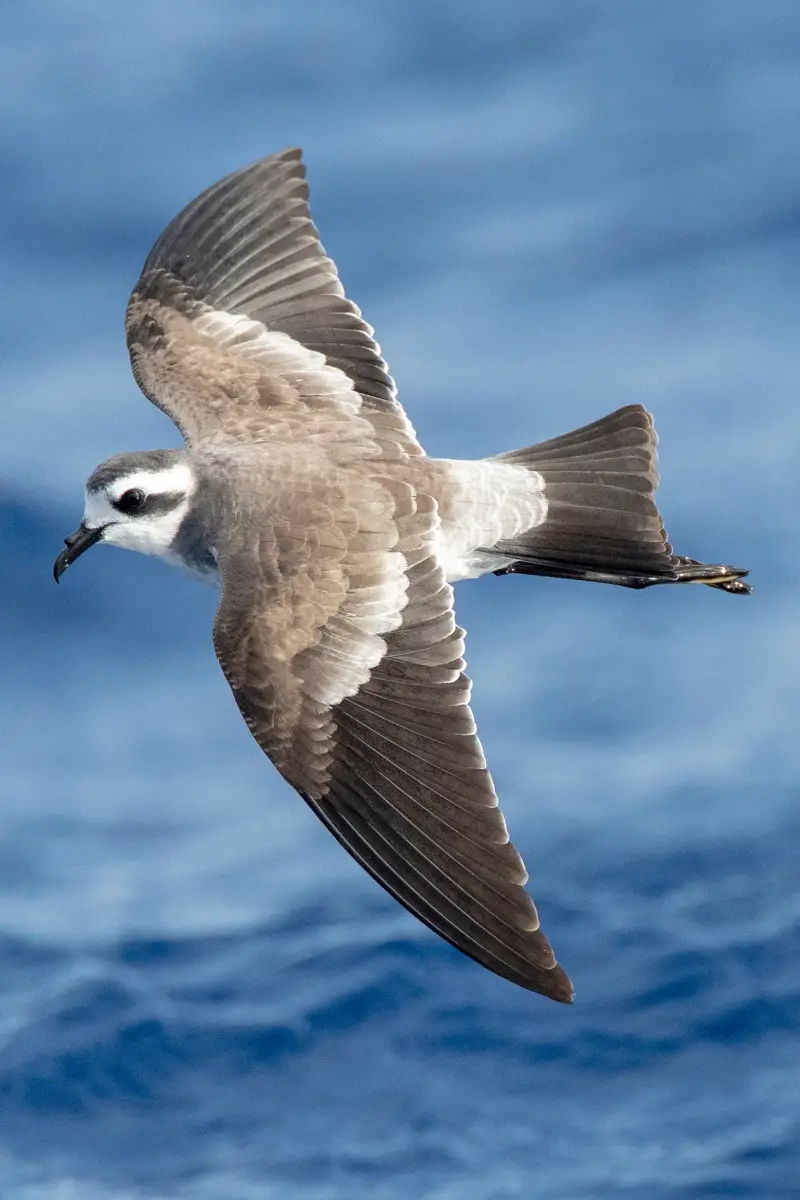
Family: Hydrobatidae, Storm-Petrels Description 7 1/2″ (19 cm). An all-black storm-petrel with shallowly forked tail and somewhat rounded wings. Ashy color of head and neck and light mottling on undersides of wings may be visible at close range. Flies with very shallow wingbeats. Similar Black Storm-Petrel larger, with longer wings and more leisurely flight style. Dark- or white-rumped Leach’s Storm-Petrel has pointier wings and flies like a nighthawk.
Habitat Open ocean; nests on rocky islands.
Nesting 1 white egg, sometimes with a ring of fine red speckling, laid in a crevice in a rock slide or in a burrow.
Range Breeds on islands from northern California south to northern Baja California.
Voice Twittering and squeaking notes given near nest burrow.
Discussion This little-known bird nests on only a few islands off the West Coast, usually in colonies of several hundred or a few thousand pairs. Such a limited range places the Ashy Storm-Petrel at risk, and indeed in the late 1960s and early 1970s researchers found evidence of thinning of eggshells caused by pesticides. Like other storm-petrels, the Ashy ejects a musky orange oil when disturbed. Its favorite food, at least in southern California, is the larvae of one of the spiny lobsters; it is also known to feed on plankton and algae.
3. California Thrasher
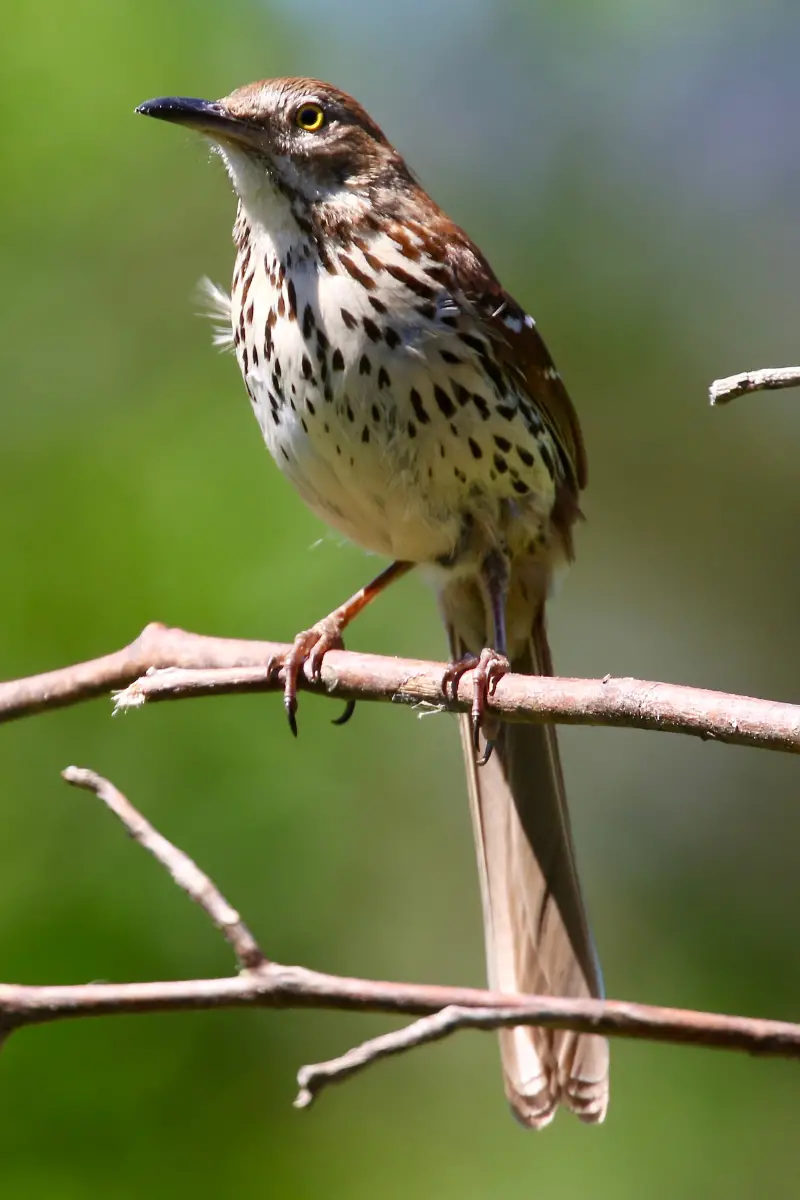
Family: Mimidae, Mockingbirds and Thrashers
Description ADULT Has mostly plain and unmarked, rich brown upperparts with subtly paler underparts flushed orange-buff on belly, flanks, and undertail coverts. Head pattern comprises subtle buff supercilium and pale throat bordered by dark malar stripe. JUVENILE Similar to adult.
Dimensions Length: 11-13″ (28-33 cm)
Habitat Fairly common resident of chaparral- covered slopes.
Observation Tips Easiest to see in spring.
Range Northwest, California
Voice An accomplished mimic, but typical song comprises chirping, whistling, and chattering phrases, each typically repeated 2-3 times; call is a soft tchak.
Discussion Similar to Crissal, but ranges do not overlap and habitat preferences differ. Note also California’s dark iris (yellow in Crissal), hint of a supercilium, lack of white “mustache” bordering dark malar stripe, and marginally shorter bill. Mostly secretive and keeps to dense cover, but sometimes seen running, tail cocked, from one thicket to another. Male sings from exposed perch, mostly in late winter and early spring, but occasionally at other seasons. Sexes are similar.
4. Elegant Tern

Family: Laridae, Gulls and Terns
Description 16-17″ (41-43 cm). A large tern with a long orange or yellow bill. White with gray mantle and wings; black cap ending in shaggy crest; deeply forked tail. In nonbreeding plumage, forehead becomes white but crown, crest, and region around eye remain black.
Habitat Lagoons and beaches.
Nesting 1 egg, often buff-colored (but the color is variable), placed in a depression on a sandy beach, usually on an island. Nests in colonies.
Range Breeds in Gulf of California and at San Diego. Winters to south and north; some to South America, others regularly visiting northern California coast.
Voice A loud grating kar-eek.
Discussion The nesting of the Elegant Tern is restricted mostly to Isla Raza, a small flat island in the northern part of the Gulf of California, where it has several colonies of hundreds of nests. Since colonies are crowded, with each female just out of bill range of her neighbors, and coastal winds obliterate landmarks that help adults find their nests, the individual color and markings of the single egg help parents recognize their own. When the eggs hatch, the color pattern of the hatchling serves the same purpose.
5. Emperor Goose

Family: Anatidae, Ducks and Geese
Dimensions Length: 26-28″ (66-71 cm)
Range Western Canada, Alaska, California, Northwest
Discussion Recalls blue morph Ross’s or Snow Goose, but plumage is much smarter, adult having welldefined white head and hindneck, black throat and foreneck, and blue-gray body plumage with scalloped pattern created by feathers’ black subterminal bands and white edges. Bering Sea specialty; breeds in eastern Siberia and western Alaska, winters on coasts of Aleutian Islands. Casual south to California.
6. Flammulated Owl
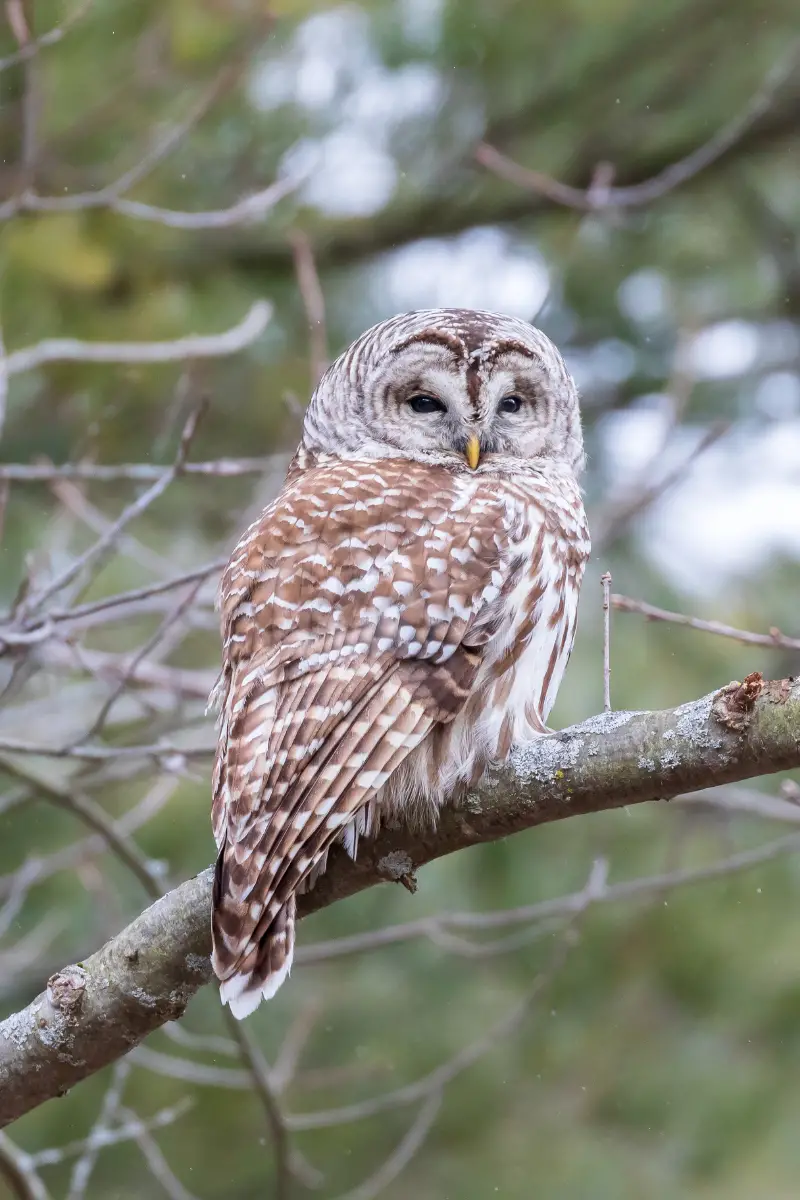
Family: Strigidae, Owls Description 6-7″ (15-18 cm). Slightly larger than a sparrow; similar to but smaller than a Western Screech-Owl, with small indistinct ear tufts, rufous edges on the facial disks, and dark eyes, rather than yellow. Grayish above, light below, with white and rust-colored markings. Sexes look similar, but female larger than male.
Habitat Coniferous woodlands and forest edges in the Northwest; dry ponderosa pine woods in the Southwest.
Nesting 3 or 4 white eggs in a tree hollow or deserted woodpecker hole.
Range Breeds in southern British Columbia south to southern California, Arizona, New Mexico, and western Texas. Winters south of United States.
Voice A monotonous low hoot, single or double, repeated almost endlessly.
Discussion As with other owls, during the breeding season the male Flammulated supplies food and protection, while the female is the chief nest-tender. Mice and similar prey are usually decapitated, the male feeding on the head, the female and young getting the softer body. Later the female leaves the nestlings and shares hunting duties with her mate.
7. Fork-tailed Storm-Petrel

Family: Hydrobatidae, Storm-Petrels
Description ALL BIRDS Mainly pale gray, but note dark and white pattern on upper wing coverts that creates a striking “V” Seen from below, note the dark underwing coverts. At close range, dark eye patch can be discerned.
Dimensions Length: 8-9″ (20-23 cm)
Habitat Nests on remote islands, but otherwise seen at sea. Fairly common northward from latitude of central California, but seldom seen from land.
Observation Tips Easiest to see on pelagic trips.
Range California, Alaska, Northwest
Voice Silent at sea, but utters rasping calls at breeding colonies.
Discussion Mainly gray plumage makes this storm-petrel unmistakable within our region. Tail is deeply forked and wings are relatively broad by storm-petrel standards. Flight is powerful, but relaxed, with occasional glides. Sexes are similar.
8. Heermann’s Gull

Family: Laridae, Gulls and Terns
Description 18-21″ (46-53 cm). Predominantly dark. Bill red; snow-white head blends into gray on neck, back, and rump; slate-black wings and tail, with white terminal band on tail and secondaries. Juveniles dusky, throat lighter, tail trimmed white, bill dark.
Habitat Coastal waters, islands, and beaches.
Nesting 2 or 3 eggs in a scrape; nests in large colonies on offshore islands.
Range Breeds on islands in Gulf of California and on San Benito Islands off west coast of Baja California. Some migrate northward from July to October, spending winter on Pacific Coast north to Vancouver Island; others migrate southward as far as Panama. Nonbreeders found year-round on coast of California; adults leave by January.
Voice A high see-whee. Also a low-pitched kuk-kuk-kuk.
Discussion This gull demonstrates that all migration in the Northern Hemisphere is not necessarily southward in fall and northward in spring. On its breeding grounds, Heermann’s Gull commonly follows fishing boats and steals fish from Brown Pelicans. Farther north it scavenges along beaches and feeds on herring eggs.
9. Horned Puffin
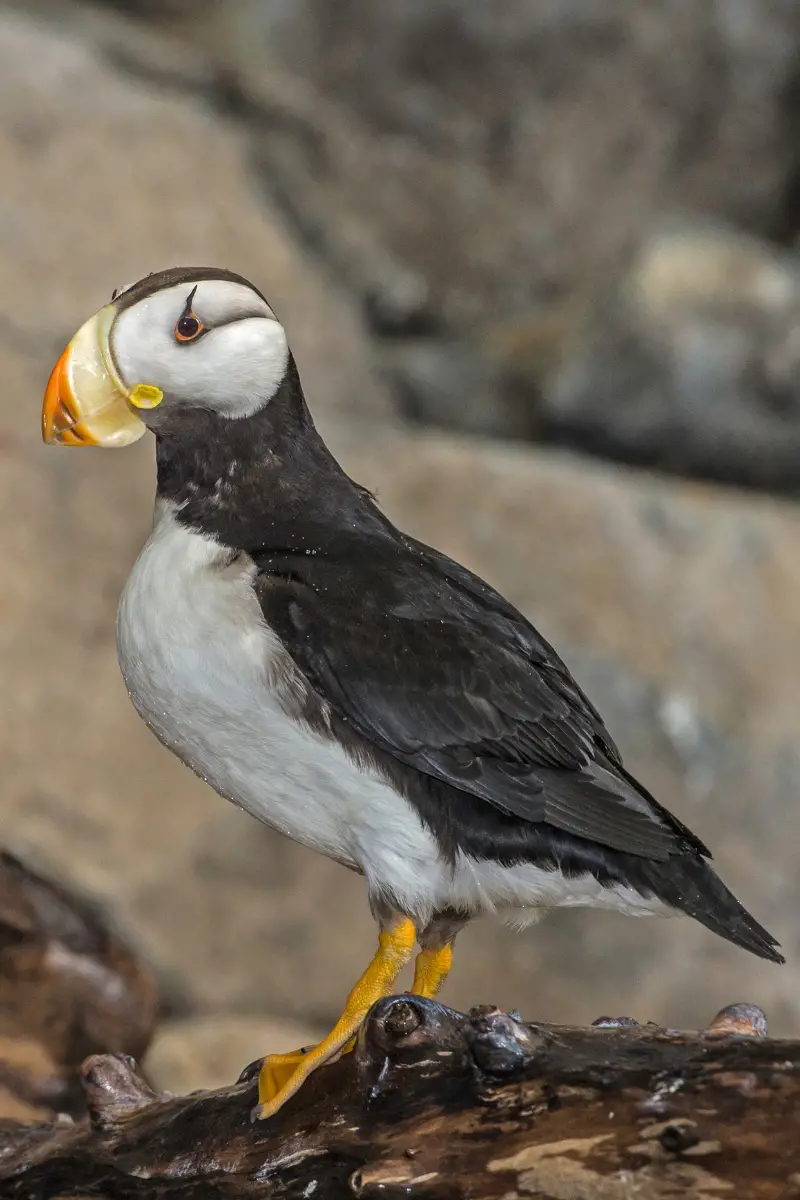
Family: Alcidae, Auks, Murres, Puffins
Description 14 1/2″ (37 cm). Pigeon-sized. Chunky tailless body. Black above, white below. White face makes head appear big; large, parrot-like bill bright yellow with red tip. Red eyelids and small black upturned “horn” above eye visible at close range. In winter, face darker, feathers brownish, bill smaller with dusky base. Young birds have darker face, narrow, sooty-brown bills.
Habitat Cold ocean waters, sea cliffs, and rocky or grass-covered islets and rocks.
Nesting 1 whitish egg, with small dark spots, in a crevice or in a deep hole among boulders. Nests in colonies.
Range Breeds from northern Alaska south to British Columbia border. Winters at sea south to Washington, rarely to California. Also in Asia.
Voice Usually silent but utters harsh notes from its burrow.
Discussion The Horned Puffin’s relatively huge bill is useful in catching and holding small fish, enabling parents to bring three or four fish at a time to their young. It is also used to signal to a mate or neighbor, especially during breeding time in crowded colonies. The colonies may contain thousands of these birds, yet in the Aleutians and on other islands where they nest among Tufted Puffins, Horned Puffins are lost among the throngs of the other species.
10. Leach’s Storm-Petrel

Family: Hydrobatidae, Storm-Petrels
Description 8-9″ (20-23 cm). A black storm-petrel with a shallowly forked tail and a white rump with a dark center; south of Central California, birds lack the white rump. Flies like a nighthawk, with much bounding and veering. This species seldom follows boats.
Habitat Open ocean; nests on spruce-covered islands and rocky coasts.
Nesting 1 white egg placed in a shallow burrow in the ground or hidden under a log. Nests in colonies.
Range Breeds on coasts and offshore islands from Aleutians south to Baja California. Also breeds in western Pacific and North Atlantic from Labrador south to Maine and Massachusetts. Winters mainly in tropical seas.
Voice A variety of trills, screams, and cooing notes.
Discussion Even near their nesting islands, Leach’s Storm-Petrels are seldom seen because they feed far out at sea and visit their burrows only at night. The presence of the birds is not difficult to detect, however; their burrows have an unmistakable musky odor, produced by an oily orange liquid that the birds emit when disturbed, and at night the air is filled with their eerie calls. Both female and male incubate the egg, changing places roughly every three days. The egg hatches in about six weeks, and the young bird leaves its burrow after about ten weeks. These birds are vulnerable to many terrestrial predators, but their nocturnal habits save them from being taken by predatory gulls. Like other storm-petrels, they feed mainly on small shrimp and other planktonic animals, which they pluck deftly from the surface of the water.
11. Least Storm-Petrel

Family: Hydrobatidae, Storm-Petrels
Description 6″ (15 cm). The smallest storm-petrel on the West Coast. An all-dark bird with short wings; tail short and wedge-shaped rather than forked. Often appears tailless at a distance. Flight swift and low, with very rapid wingbeats.
Habitat Open ocean.
Nesting 1 white egg placed in a crevice among rocks. Nests in colonies.
Range Breeds on islands off both coasts of Baja California. In summer and fall ranges northward to San Diego County, California.
Voice Twittering and squeaking notes at nesting colonies.
Discussion The world’s smallest storm-petrel, this species is probably the least-known member of its family in North America. But its dark color, small size, and tailless look make it the easiest West Coast storm-petrel to identify.
12. Mountain Plover

Family: Charadriidae, Plovers
Description 8-9 1/2″ (20-24 cm). A long-legged, sandy-brown plover. Breeding adult has black forecrown, white forehead, and thin black eye line. In winter adults and young birds, face plain, dark eye conspicuous. In all plumages, whitish wing stripe, whitish wing linings, black band near tail tip.
Habitat Arid plains, short-grass prairies, and fields.
Nesting 3 dark olive eggs, heavily spotted with brown, in a shallow depression on the ground, sometimes lined with bits of cow dung, twigs, or grass.
Range Breeds in Montana, Wyoming, Colorado, New Mexico, and Texas Panhandle east to Nebraska. Winters from central California and southern Arizona southward into Mexico.
Voice A harsh single note, krrrp.
Discussion With its range centered on the short-grass prairie, a region subject to heavy grazing and cultivation, the Mountain Plover has been drastically reduced in number. It feeds singly or in small flocks, mostly on insects. In winter larger concentrations can be seen.
13. Oak Titmouse
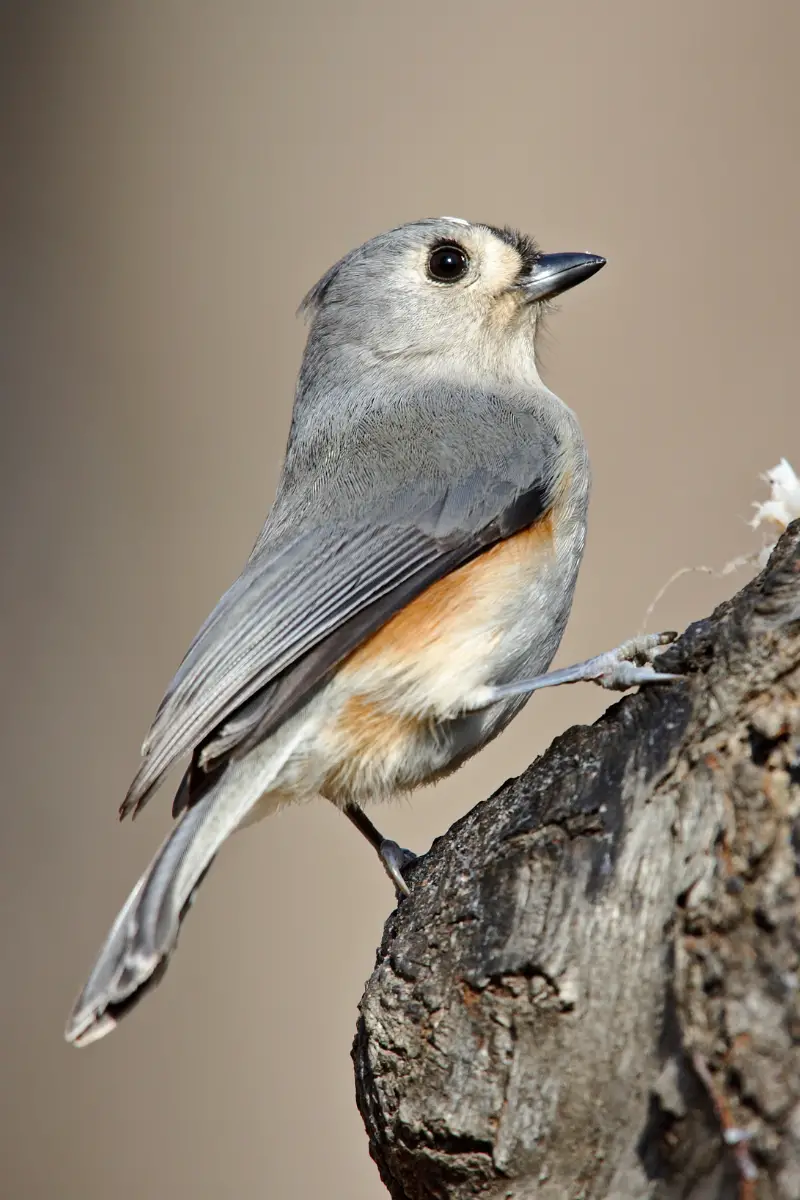
Family: Paridae, Chickadees and Titmice
Description ADULT Has plain and unmarked warm gray-brown upperparts including tail; note the short but distinct crest. Underparts are pale gray, with a subtle or barely visible pinkish or warm buffy wash on flanks. Bill is pointed and gray, and legs are dark gray. Subtle plumage variation exists within the species’ range and several subspecies are recognized. JUVENILE Similar to adult.
Dimensions Length: 5-5 1/2″ (13-14 cm)
Habitat Fairly common resident within its rather limited range on the Pacific slopes of California and Oregon; although by no means restricted to oak woodland, this is its favored habitat.
Observation Tips For beginners, geographical range is the best initial clue to separation from Juniper Titmouse, especially since both species are rather sedentary in their habits. Get to know this species first in areas where it does not overlap with Juniper.
Range Northwest, California
Voice Song comprises a varied range of whistling notes including peechew; calls include a sharp tsi-chrr.
Discussion Charming little titmouse with rather nondescript plumage. Obvious titmouselike structure and absence of any striking plumage features are good clues to separate it from most other species, except Juniper Titmouse, with which it was formerly considered conspecific. For separation from that species, note subtle differences in plumage and more distinct differences in habitat preference and geographical range. Sometimes seen in small parties outside the breeding season and occasionally joins roving mixed-species flocks. Sexes are similar.
14. Parakeet Auklet
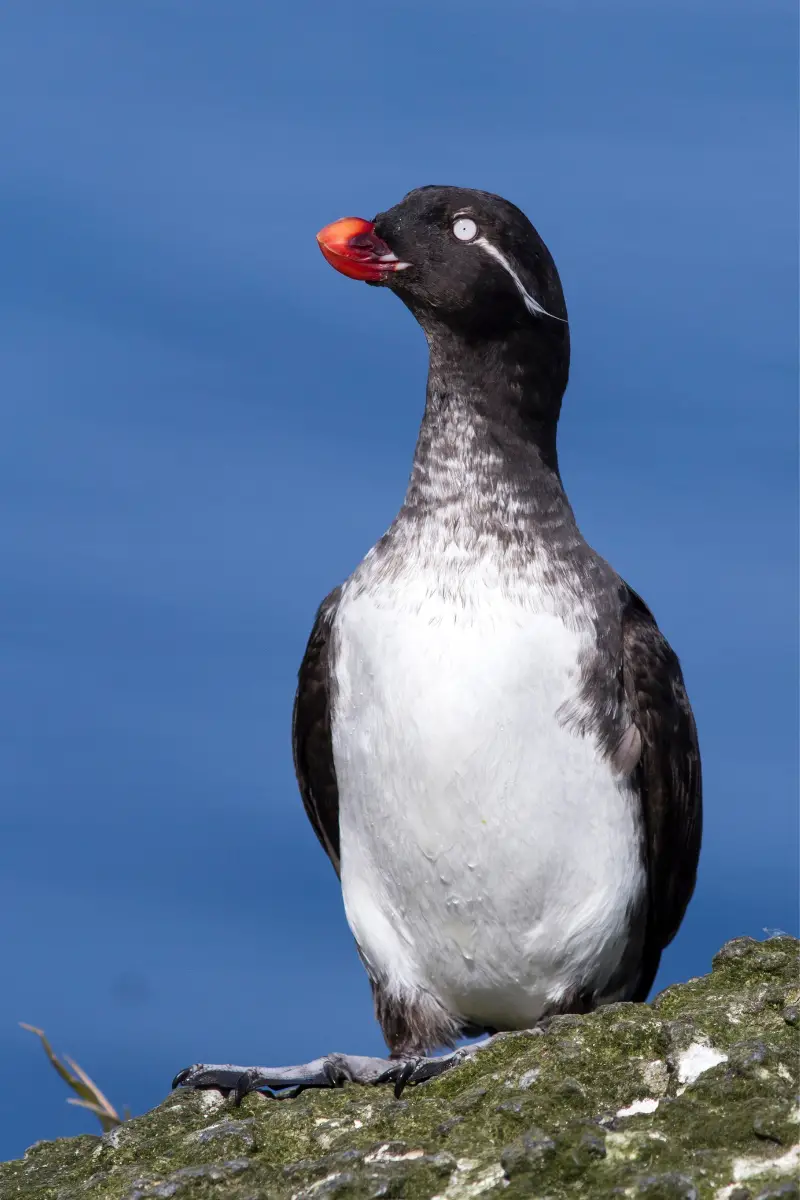
Family: Alcidae, Auks, Murres, Puffins
Description 10″ (25 cm). A robin-sized auklet whose short tail and chubby body make it look larger. Sooty black above, white below. In summer, white, mustache-like plume extends from below eye to lower neck. Stubby upturned red bill. In winter, white plume lacking, throat and underparts white, bill duskier.
Habitat Open ocean; nests on coastal or island cliffs.
Nesting 1 white oval egg in a cliff crevice or among boulders.
Range Breeds on Bering Sea islands and nearby coasts. Winters offshore, very rarely south to California.
Voice Generally silent, clear whistles in breeding colonies.
Discussion This auklet, common on its Alaskan home grounds, does not form large colonies but mainly nests scattered among the puffins and Pigeon Guillemots that prefer the same habitat. Adults sit high up on the cliffs, each on watch near its nesting cavity while its mate is incubating or tending the young. In the morning or afternoon it leaves the cliff to feed, diving for krill (a kind of crustacean), which it captures near the sea bottom.
15. Red-footed Booby

Family: Sulidae, Boobies and Gannets
Description 26-30″ (66-77 cm). W. 36-40″ (91-101 cm). Smallest of the sulids. Plumage highly variable. Three principal adult color phases; all have straight, pale blue bills, bright red feet, bare pink facial skin at base of bill. White-phase adults are all white with dark flight feathers, have a dark carpal patch on the underwing, and a variable golden-yellow wash; white-tailed form is all brown with white rump and tail; the white-headed brown form resembles white-tailed, but in addition the head and neck are white (Pacific only). Juveniles pale brown with drab yellowish-gray feet; blackish-brown bill; matures over 2-3 years.
Habitat Open oceans and subtropical islands (e.g., Dry Tortugas).
Nesting Nests colonially in tree cavities on tropical islands; one egg; engages in “sky pointing” display similar to other sulids, but given in trees; nesting dates vary with location and conditions; large egg and long incubation period; young develop slowly.
Range Breeds on tropical islands worldwide, including Caribbean, Galapagos, Indian Ocean; strays to Dry Tortugas off Florida, accidental off Gulf and California coasts.
Voice Usually silent at sea.
Discussion A pantropical species, the Red-footed’s lifestyle is adapted to the relatively nutrient-poor waters in which it hunts for fish and squid; when feeding young, engages in long foraging flights, at times exceeding 90 miles (150 km); may follow ships for long distances; flies quickly and gracefully, plunge dives or snatches flying fish in mid-air; nocturnal habits discourage piracy by frigatebirds. Local populations may crash with the cyclical loss of food species, or with deforestation of tropical islands.
16. Red-tailed Tropicbird

Family: Phaethontidae, Tropicbirds
Description 30-37″ (76-94 cm), including tail. W. 41″ (104 cm). Adults have deep red bills, mostly white body plumage, dark eye patch, and thin red tail streamers (often difficult to see in the field). Juvenile lacks tail streamers, has black bill and barred upperparts; when approaching maturity, juvenile’s bill changes from black to yellow, then red; during this transition, may be confused with White-tailed Tropicbird.
Habitat Highly pelagic; seldom seen anywhere near shore in our area.
Nesting Nesting period for various populations at tropical sites extends through the year; single egg on hard rock or in crevice.
Range Breeds on tropical islands of the Indian and Pacific oceans. Disperses widely after breeding. Occurs in North American waters as an accidental off southern California.
Voice Usually silent at sea.
Discussion A rare straggler in North American waters, the Red-tailed may engage in courtship “bicycling flight” where one bird hovers above the other, then shifts position with the other. Chunky in appearance, the Red-tailed seems ponderous in flight, less smooth than its congeners. Seldom pursues ships.
17. Rhinoceros Auklet

Family: Alcidae, Auks, Murres, Puffins
Description ADULT SUMMER Has gray-brown upperparts, darkest on crown, nape, back, and wings; neck and chest are also gray-brown, but underparts are otherwise whitish. Has shaggy white plumes running back from eye and from base of bill. Bill is orange-yellow, relatively large (like a scaled-down puffin bill) and with a forward-projecting, pale hornlike plate after which species is named. Iris is white. ADULT WINTER Similar, but white plumes are much-reduced and bill is smaller, duller, and lacks the projecting “horn.” JUVENILE Similar to winter adult, but bill is smaller and duller still, and iris is darker.
Dimensions Length: 14 1/2-15 1/2″ (37-39 cm)
Habitat Widespread and locally common, breeding colonially on islands and nesting in burrows; activity at colonies is mainly nocturnal. Suffers badly on islands where ground predators have been introduced. Otherwise seen at sea, range extending south in winter to Baja California.
Observation Tips As auklets go, one of the easier species to see, partly because of wide-ranging distribution, but also because it often feeds in inshore seas, even outside breeding season, making it easier to observe from land. You are most unlikely to see the species on land, however, unless you visit a colony after dark.
Range California, Northwest, Alaska, Western Canada
Voice Utters groaning calls, after dark, at colonies. Otherwise silent.
Discussion Relatively large and bulky alcid. Breeding season bill ornamentation is distinctive and diagnostic, even in silhouette. Swims buoyantly and often seen in flocks. Sexes are similar.
18. Spotted Dove
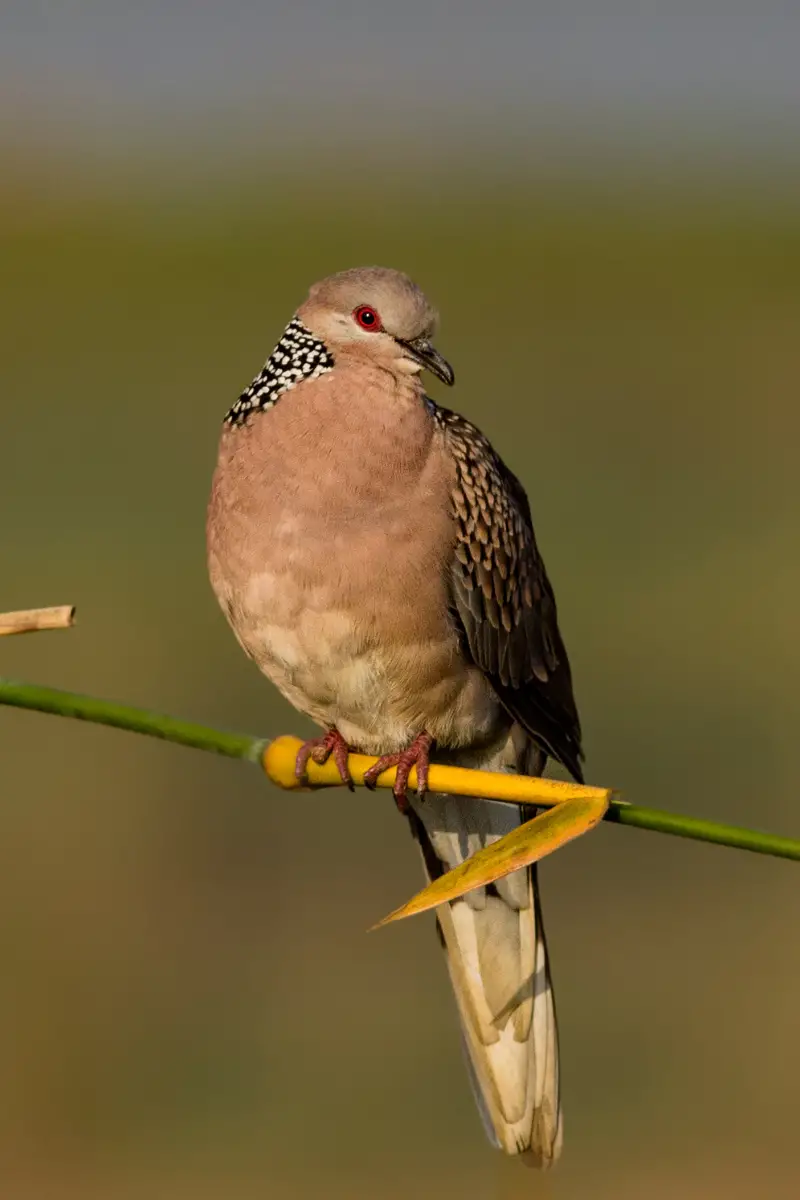
Family: Columbidae, Pigeons and Doves
Description 13″ (33 cm). Larger and stockier than Mourning Dove. Dark cinnamon-gray above, buffy below. Light gray head; wide black collar; white spots on hindneck. In flight, long blunt tail looks black with flashy white corners. Juveniles lack collar on hindneck.
Habitat Suburban areas and gardens.
Nesting 2 white eggs in a flimsy stick platform in a tree.
Range Asia native introduced in coastal southern California.
Voice A 3-syllable rolling coo-coo-cooooo.
Discussion This dove seems to be a harmless addition to the southern California garden avifauna, feeding on seeds and nesting quite secretively. The courting male may be observed bowing rhythmically, then flying up with tail spread wide.
19. Tufted Puffin

Family: Alcidae, Auks, Murres, Puffins
Description ADULT SUMMER Has very dark brown plumage that in most situations appears almost jet-black. Note, however, contrasting gleaming white face. Eye has white iris and red orbital ring, and shaggy golden-yellow tufted plumes arise from behind eye. Laterally flattened bill is massive and horny-looking. Lower mandible is orange-red while upper mandible has orange-red outer half and yellow inner half; note swollen orange base of gape. ADULT WINTER Has entirely dark sooty brown plumage. Eye has pale iris and dull red orbital ring. Bill has smaller plates than in summer and is mainly dull orange, but grubby yellow toward base of upper mandible. JUVENILE Similar to winter adult in plumage terms, but has much smaller, shallower, and stubbier bill.
Dimensions Length: 14 1/2-15 1/2″ (37-39 cm)
Habitat Widespread breeding species on Pacific coast, from California (where it is scarce and very local) to Alaska (where it is locally abundant). In breeding season, often seen swimming in inshore seas in vicinity of colonies. Nests in burrows on islands. Outside breeding season, more widespread, but mainly pelagic and offshore.
Observation Tips Easy to see in breeding season if you visit a colony. Otherwise, sightings relate to chance encounters at sea.
Range Western Canada, California, Northwest, Alaska
Voice Mainly silent although incubating birds utter grumbling calls from within burrows.
Discussion Large, plump-bodied and unmistakable alcid, particularly so in breeding season when its head adornments and bill colors lend it an almost comical appearance. Swims sedately and dives frequently after fish. In flight, which is direct and powerful, bright orange-red feet and legs are obvious; webbed feet are proportionately large. Adopts upright posture when standing on rock. Sexes are similar.
20. Western Gull
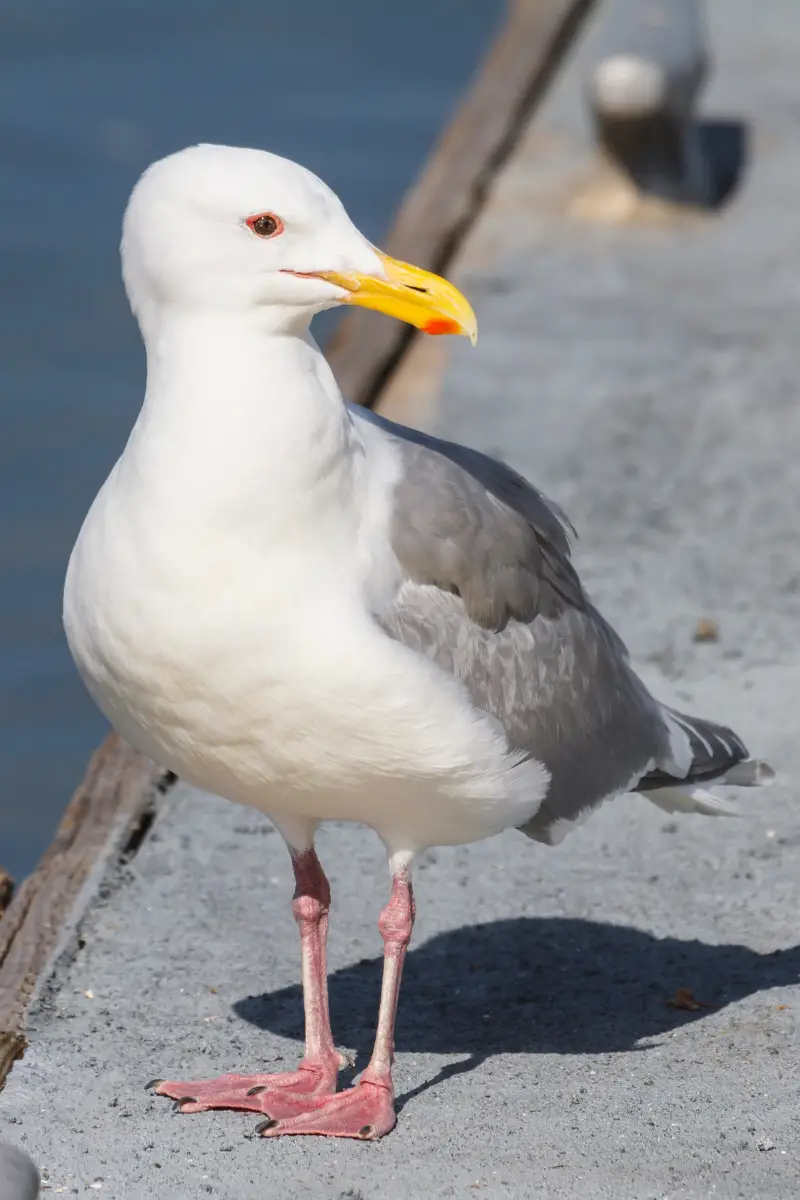
Family: Laridae, Gulls and Terns
Description 24-27″ (61-69 cm). Snow white, with dark slate-colored back and wings. Yellow eye and bill; breeding adult has a red dot near tip of lower mandible. Pinkish or flesh-colored feet. In winter, head and nape faintly dusky. First-year birds dark gray-brown with dark, almost black primaries, contrasting with lighter areas on nape and rump; dark bill. See Yellow-footed Gull.
Habitat Coastal waterways, beaches, harbors, dumps; open ocean.
Nesting 3 light buff, blotched eggs in a grass or seaweed nest in a depression, protected and slightly isolated by broken terrain. Nests in colonies on rocky headlands, islands, or dikes.
Range Breeds on Pacific Coast from Washington to Baja California. In winter regularly occurs north to British Columbia.
Voice Squeals and raucous notes.
Discussion The large gulls of the Pacific Coast have a common ancestor but evolved separately in isolation. The Glaucous-winged Gull resembles the Western Gull in size and habits, but its coloration is extremely light. The two species regularly hybridize in the Pacific Northwest.
21. White-tailed Hawk

Family: Accipitridae, Hawks and Eagles
Description ADULT Has gray head and back, rufous “shoulders” (inner wing coverts), dark wings, and white underparts; tail is white with a broad, black subterminal band. In flight, white body, underwing coverts, inner flight feathers, and tail contrast with dark primaries (note the white patch near tips of outer flight feathers), dark trailing edge to wing and dark tail band. From above, white tail and rump, and red “shoulders” are striking. JUVENILE Mainly dark with white breast and vent, and white marks on head; tail is buffy gray, barred, and with a pale base on upperside. Adult plumage is acquired gradually over successive molts.
Dimensions Length: 21-23″ (53-58 cm); Wngspn: 4′ (1.2 m)
Habitat Widespread in Central and South America; resident in southern Texas on prairies and agricultural grassland and coastal scrub.
Observation Tips Visit Attwater National Wildlife Refuge.
Range Texas, California
Voice Utters a shrill kee-ke-kee-ke’de-ke’deÖ
Discussion Specialty of southern Texas. Adult’s short, mostly white tail with black subterminal band, and red “shoulders,” are striking and diagnostic in combination. Immatures have less distinctive plumage and longer tail than adult but in all birds wingtips extend well beyond tail when perched. Sexes are similar.
22. White-winged Parakeet

Family: Psittacidae, Parrots and Allies
Description 9″ (23 cm). A small, stocky green parakeet with pointed tail and flash of yellow and white in wing.
Habitat Suburban areas, parks, and gardens.
Nesting 5 white eggs placed in a natural cavity or in a dense cluster of dead palm fronds.
Range Native to tropical America. Introduced and established in southern California and southern Florida.
Voice A rapid series of shrill metallic notes.
Discussion This boldly marked parakeet frequently escapes domestic confinement and can be seen occasionally in the heart of large cities like New York and San Francisco. But it nests successfully in the wild only in California and Florida.
23. Yellow-footed Gull
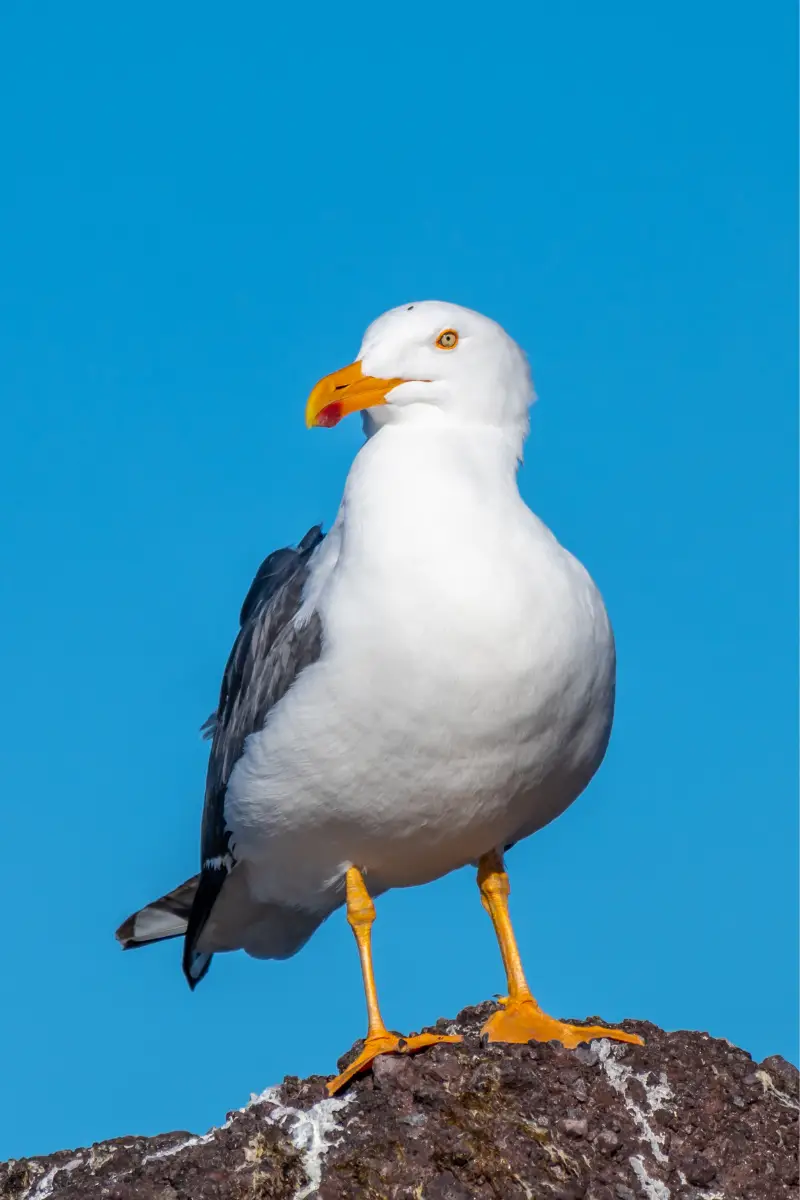
Family: Laridae, Gulls and Terns
Description 21-23″ (53-58 cm). Similar to Western Gull, but legs yellow. First-winter birds have pink legs like Westerns but are paler, with contrasting white belly.
Habitat Beaches, harbors, dumps; open ocean.
Nesting 3 light buff, blotched eggs in a grass or seaweed nest placed in a depression, on rocky headlands or islands.
Range Resident in Gulf of California; visits Salton Sea and San Diego area mainly in summer and fall.
Voice Similar to calls of Western Gull, but deeper.
Discussion Formerly considered a subspecies of the more widespread Western Gull, the Yellow-footed is only a wanderer within the area covered by this guide. A strictly coastal bird, it favors the immediate shoreline at the Salton Sea.
24. Red-throated Pipit
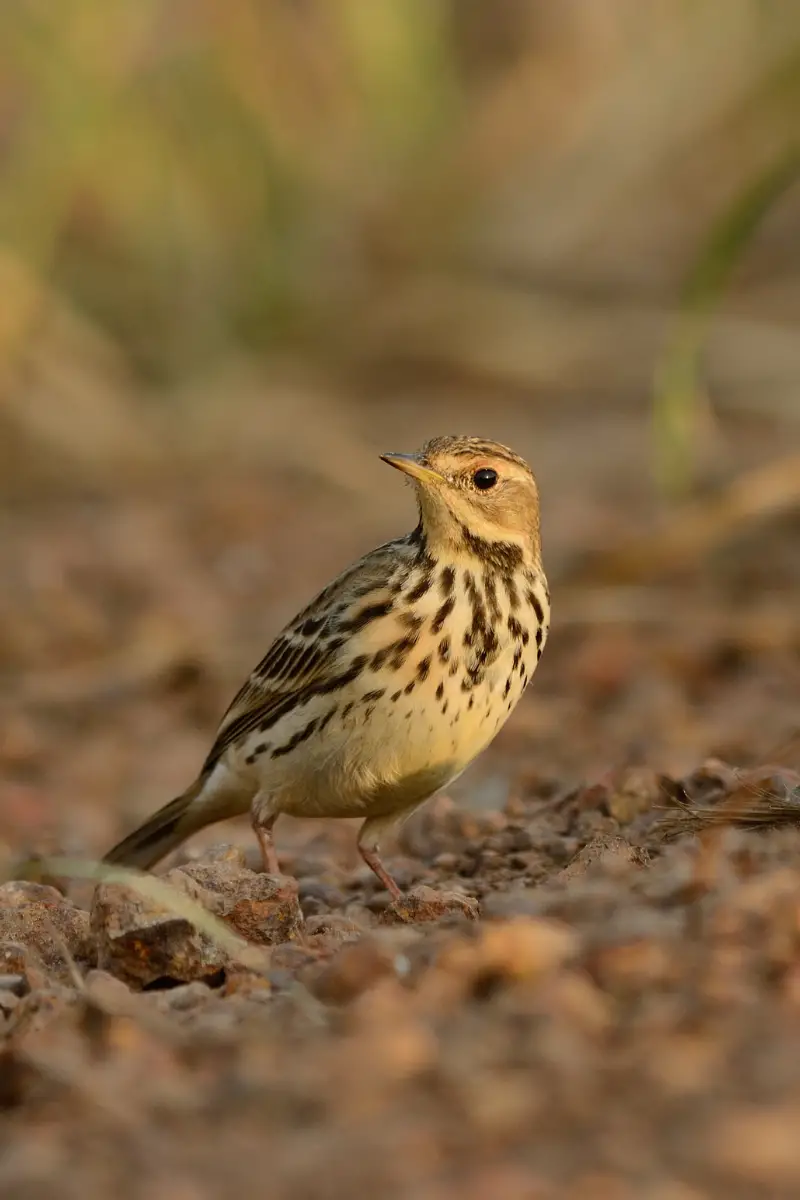
Family: Motacillidae, Wagtails and Pipits
Description 6″ (15 cm). Sparrow-sized; slim, long-legged ground bird; erect stance. Light brown above, with dark streaking on mantle; indistinct white wing bars. In winter, buff-white below, heavily streaked on sides of neck and breast, extending to flanks. In summer, face, throat, and breast washed with wine-red or pink.
Habitat Shrubby tundra or open areas of forest tundra; in winter, fallow agricultural fields, meadows, or beaches.
Nesting 5-7 bluish eggs, spotted with brown, in a grass nest lined with fine material, on the ground sheltered by a tussock.
Range Breeds in western Alaska. Winters in Old World, but a few turn up along Pacific Coast in fall and winter. Also in Eurasia.
Voice Call a sharp seeep, or see-eep.
Discussion A ground feeder in its territory, this pipit sings from the top of shrubs or, more often, in the air, as it rises slowly and then silently falls with wings and tail spread.

